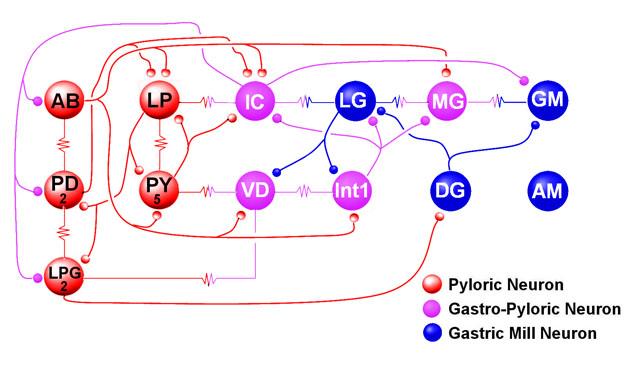Captivating Rhythm
- Published1 Nov 2009
- Reviewed16 Nov 2012
- Author Debra Speert, PhD
- Source BrainFacts/SfN
Rhythm is universal — all over the world, people respond to a steady tempo. Strong beats drive people to dance. Even young children seem to instinctively know how to move to music. Perhaps we are all so sensitive to rhythm because it drives so much of our biology. Our hearts beat rhythmically, and we wake and sleep to circadian rhythms. These intrinsic rhythms are associated with rhythmic activity in the brain. Perhaps it is fitting that rhythmic brain activity is vital to produce the movements that comprise dance.
Lobsters have simplified neural pathways, which makes them good models to study the circuitry of the nervous system.
Courtesy, with permission, Eve Marder, PhD, Brandeis University; Illustration: © 2003 Benjamin Marder
Even in relatively simple nervous systems, brain cells form complex connections. These connections, often illustrated in circuit, like the one shown here from the crab stomatogastric nervous system, form the foundations for behavior and much of physiology.
Courtesy, with permission, Eve Marder, PhD, Brandeis University
Even small changes to these natural rhythms can have dire effects on the whole animal. Diseases like depression and injuries like repeated concussions can throw rhythms off balance, ultimately resulting in changes in cognition, mood, and behavior. In living creatures, specialized neuronal circuits called central pattern generators (CPGs) produce rhythmic behaviors, like walking, swimming, breathing, and chewing. The cells found in these circuits produce electrical discharges in an “oscillatory” pattern that repeats.
Model Nervous System
Researchers have learned much about CPGs and the rhythmic activity of the nervous system by studying crustaceans, like crabs and lobsters. Compared with most mammals, these animals have simpler nervous systems, so they are attractive models for understanding how neural circuits produce rhythmic behaviors.
Researchers, including the 2016 Kavli Prize winner and SfN Past President Eve Marder, have been particularly interested in the stomatogastric nervous system (STG) in these animals. The STG is the part of the crustacean central nervous system that controls the movement of the stomach. The STG contains about 30 nerve cells that are organized into two different rhythmic CPGs. Researchers have mapped the connections between these cells, and the resulting web-like network can be studied to obtain insights into how larger neural networks function.
Constantly Active
Where does the rhythmic activity of CPGs come from? Even when they are removed from the body, groups of STG nerve cells maintain their rhythmic firing patterns. These findings demonstrate that the rhythmic activity is intrinsic to the CPG. Rather than wait for something to trigger their activity, these circuits are constantly active.
These crustacean studies reveal an important principle about all neural networks: the nervous system is constantly active. It does not wait passively for a stimulus to turn it on. The nervous system is active day and night, whether an organism is asleep or awake, although the patterns of activity are different during sleep than when the animal is awake. Research indicates that sensory stimuli modify internally generated activity. For example, the animal’s ingestion of food alters the firing rhythm of STG cells and ultimately increases movement in the stomach. Similarly, the presence of a predator changes CPG firing rhythm, resulting in swimming behavior aimed at escape.
Changing Tempo
Sensory stimuli are not alone in modifying rhythms. Natural and not-so-natural chemicals modify CPG rhythms as well. Marder’s lab has shown that chemicals called neuromodulators fundamentally alter the activity produced by neuronal circuits so that the circuits can produce different behaviors. For example, one substance might increase a rhythm’s rate and amplitude, while another substance might silence the rhythm.
Because of the network structure of brain circuits, changing the rhythm of one brain cell can influence many others. In fact, throughout the nervous system, individual neural networks interact forming one master network web.
So, seemingly remote modifications can affect the whole animal. By showing how small changes in the chemical environment can affect many nerve cells and the behaviors they produce, these studies offer insight into the dramatic effects of disorders like depression. Upsetting the balance of brain chemicals changes the state of brain circuits, profoundly altering mood and behavior.
In studying cellular rhythms in crabs and lobsters, researchers are discovering the mechanisms driving our rhythms — those in dance, thought, and sleep.
CONTENT PROVIDED BY
BrainFacts/SfN
Also In Archives
Trending
Popular articles on BrainFacts.org




















